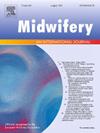Multifactorial determinants of postpartum care uptake in low- and middle-income countries: A systematic review and meta-analysis
IF 2.5
3区 医学
Q1 NURSING
引用次数: 0
Abstract
Background
Postpartum care (PPC) uptake within six weeks after delivery is essential to prevent maternal morbidity and mortality.
Aim
to understand the determinants contributing to PPC uptake in low-and-middle income countries (LMIC).
Method
PubMed, Embase, CINAHL, Cochrane, Web of Science databases were searched on PPC uptake for childbearing women in LMIC. Studies published in English in peer-reviewed journals since 2013 were eligible. A meta-analysis using a random-effect model was undertaken to measure the pooled effect of five key determinants of PPC uptake.
Findings
Among 1602 generated records, 24 cross-sectional studies were selected for the review. Nine of them were included in the meta-analysis (n=198 402 women). Overall, 55.4 % of women used PPC. The pooled findings of PPC uptake were associated with urban locations (OR=1.88, 95 % confidence interval (CI):0.76-1.91), and women’s primary (OR=1.45,95 %CI:1.31-1.61) and secondary (OR=1.67,95 %CI:1.45-1.92) education levels. Moreover, women from poor (OR=1.38,95 %CI:1.23-1.56), middle (OR=1.56,95 %CI:1.35-1.80), richer (OR=2.01,95 %CI:1.71-2.35) and the richest (OR=3.31,95 %CI:2.82-3.88) households were more likely to use PPC. Other facilitators included: PPC awareness, knowledge of postpartum morbidities, antenatal care, skilled birth attendant, health facility-based delivery, caesarean, women’s autonomy in decision-making, wanted pregnancy, primiparity, mass media exposure, women’s partner education and employment. Barriers to PPC uptake included: distance from health facilities, single marital status, unwanted pregnancy, cultural belief.
Conclusion
The differences in PPC uptake in LMIC reflect social inequities. These findings can inform equitable maternal health policies and programs in LMICs. Strengthening community outreach and addressing structural barriers by improving PPC quality and access may enhance uptake and reduce preventable complications.
低收入和中等收入国家产后护理吸收的多因素决定因素:系统回顾和荟萃分析
产后护理(PPC)在分娩后六周内的吸收是必不可少的,以防止产妇发病率和死亡率。目的了解影响中低收入国家(LMIC)采用PPC的决定因素。方法检索pubmed、Embase、CINAHL、Cochrane、Web of Science等数据库,分析低收入低收入地区育龄妇女PPC的使用情况。自2013年以来在同行评议期刊上发表的英文研究符合条件。采用随机效应模型进行荟萃分析,以测量PPC摄取的五个关键决定因素的综合效应。在1602份生成的记录中,选取了24份横断面研究进行综述。其中9名纳入meta分析(n= 198402名女性)。总体而言,55.4%的女性使用PPC。PPC吸收的汇总结果与城市位置(OR=1.88, 95%可信区间(CI):0.76-1.91),以及妇女的小学(OR=1.45, 95% CI:1.31-1.61)和中学(OR=1.67, 95% CI:1.45-1.92)教育水平有关。此外,来自贫困家庭(OR=1.38, 95% CI:1.23-1.56)、中等家庭(OR=1.56, 95% CI:1.35-1.80)、较富裕家庭(OR=2.01, 95% CI:1.71-2.35)和最富裕家庭(OR=3.31, 95% CI:2.82-3.88)的妇女更有可能使用PPC。其他促进因素包括:母婴保护意识、产后发病率知识、产前护理、熟练助产人员、保健设施分娩、剖腹产、妇女在决策中的自主权、想要怀孕、初产、大众媒体曝光、妇女伴侣教育和就业。采用PPC的障碍包括:远离卫生设施、单身婚姻状况、意外怀孕、文化信仰。结论低收入人群PPC摄取的差异反映了社会不公平。这些发现可以为中低收入国家公平的孕产妇保健政策和规划提供信息。通过提高PPC的质量和可及性,加强社区外展和解决结构性障碍,可提高使用率并减少可预防的并发症。
本文章由计算机程序翻译,如有差异,请以英文原文为准。
求助全文
约1分钟内获得全文
求助全文
来源期刊

Midwifery
医学-护理
CiteScore
4.50
自引率
7.40%
发文量
221
审稿时长
13.4 weeks
期刊介绍:
Midwifery publishes the latest peer reviewed international research to inform the safety, quality, outcomes and experiences of pregnancy, birth and maternity care for childbearing women, their babies and families. The journal’s publications support midwives and maternity care providers to explore and develop their knowledge, skills and attitudes informed by best available evidence.
Midwifery provides an international, interdisciplinary forum for the publication, dissemination and discussion of advances in evidence, controversies and current research, and promotes continuing education through publication of systematic and other scholarly reviews and updates. Midwifery articles cover the cultural, clinical, psycho-social, sociological, epidemiological, education, managerial, workforce, organizational and technological areas of practice in preconception, maternal and infant care.
The journal welcomes the highest quality scholarly research that employs rigorous methodology. Midwifery is a leading international journal in midwifery and maternal health with a current impact factor of 1.861 (© Thomson Reuters Journal Citation Reports 2016) and employs a double-blind peer review process.
 求助内容:
求助内容: 应助结果提醒方式:
应助结果提醒方式:


